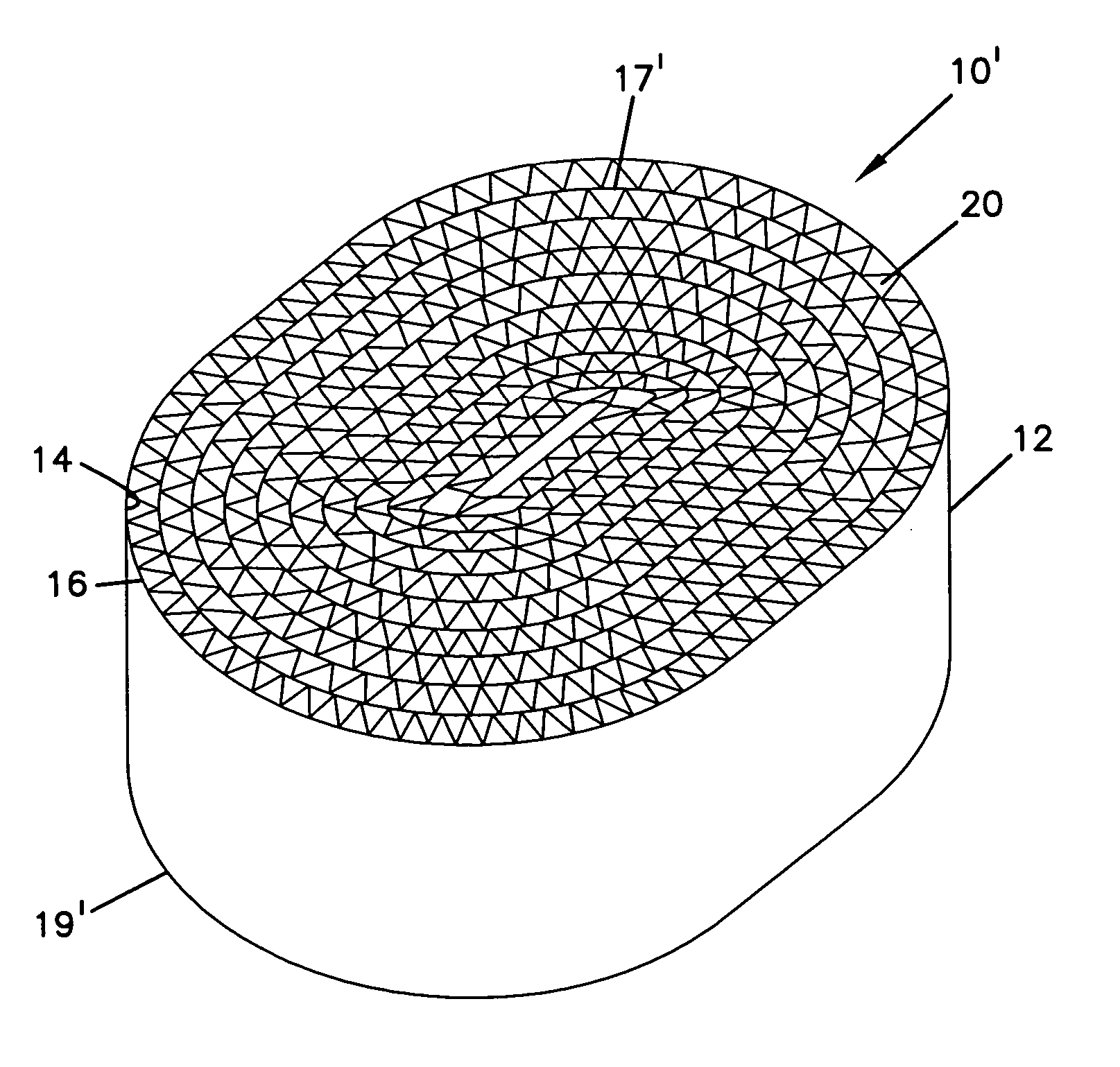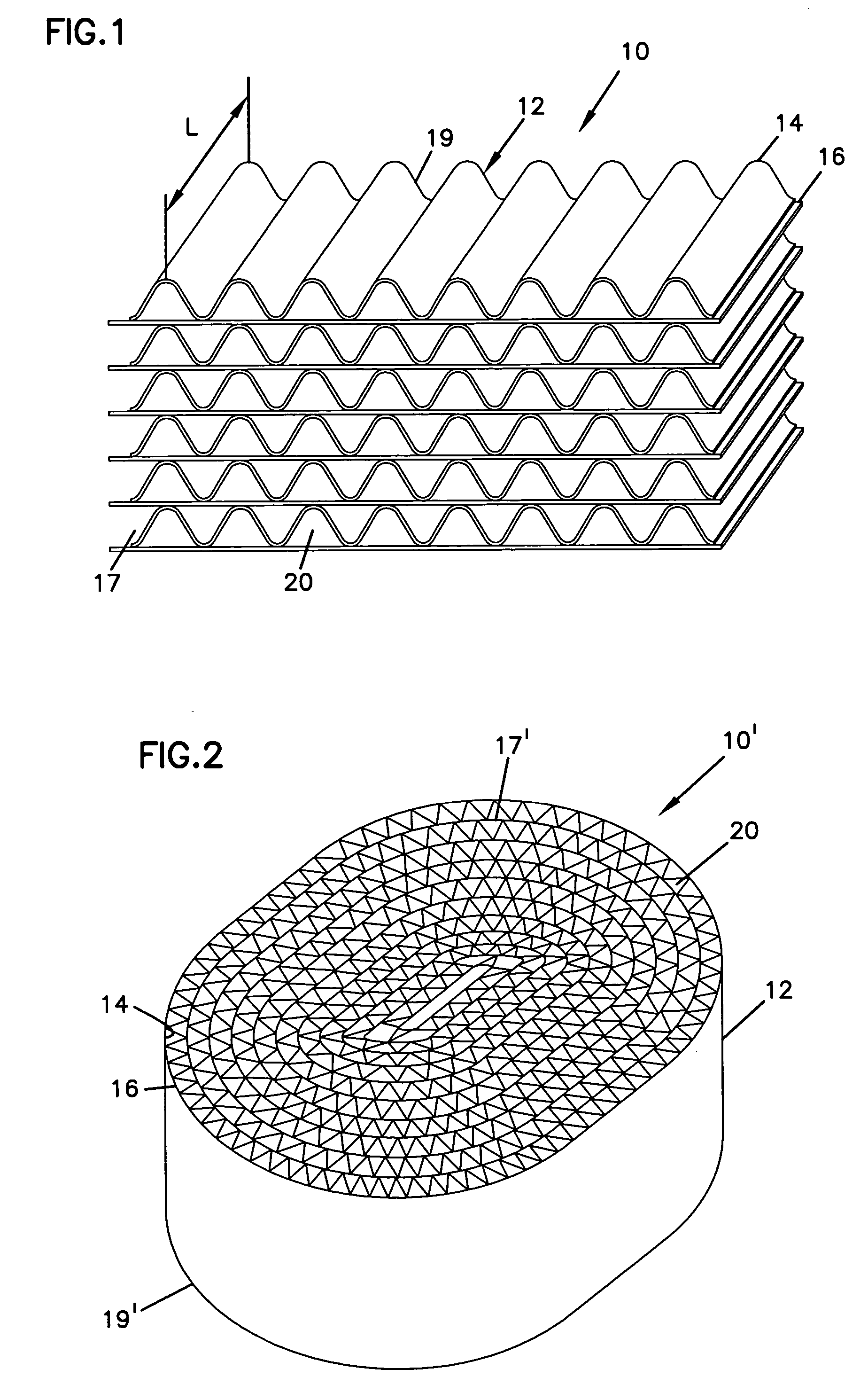Alkaline impregnated filter element, and methods
a filter element and impregnated technology, applied in gravity filters, filtration separation, separation processes, etc., can solve the problems of reducing the useful life tortuous path for air flowing, and reducing the useful life of filters. , to achieve the effect of enhancing the oxidation reaction, reducing the life of prior art filters, and reducing the number of oxidative reactions
- Summary
- Abstract
- Description
- Claims
- Application Information
AI Technical Summary
Benefits of technology
Problems solved by technology
Method used
Image
Examples
examples
[0081] The following non-limiting examples will further illustrate the invention. All parts, percentages, ratios, etc., in the examples are by weight unless otherwise indicated.
[0082] The following substrate body was used for the example contaminant-removal elements:
[0083] Body 1: Body 1 was similar to that of FIG. 2, formed by alternating a flat facing sheet and a sinusoidal corrugated sheet. The sheets were made from 60% cellulose fibers and 40% PET fibers. The sheets were wrapped to form a cylinder. The resulting domed passages had an approximate height of 1.05 mm and width of 2.90 mm. The cross-sectional area of each passage was about 1.5 mm2. The sheets were held together by the thermoplastic material from the sheets, which had been melted with heat created by ultrasonic energy, and then had cooled.
[0084] The bodies were impregnated with basic material by the following method. A volume of basic solution was placed in a beaker. The fibrous body was placed into the beaker, so ...
example 1
[0092] A solution of 20 wt-% K2CO3 and 6.6 wt-% KI in water was made. Body 1, having a diameter of about 3.8 cm and a length of about 7.5 cm, was impregnated with the solution. Example 1 was tested with Breakthrough Test 1, and the results are illustrated in the graph of FIG. 7.
[0093]FIG. 7 shows the SO2 levels passing through the tested filter elements over time.
[0094] It is seen that Example 1, which included a promoter, provides better SO2 removal than the Comparative Examples.
example 2
[0096] A solution of 20 wt-% K2CO3 and 6.6 wt-% KI in water was made. Body 1, having a diameter of about 3.8 cm and a length of about 7.5 cm, was impregnated with the solution. Example 2 was tested with Breakthrough Test 2. A photograph of the tested sample is illustrated in FIG. 8.
[0097] The quantitative test results for Comparative Example C and Example 2, from Breakthrough Test 2, showed that the filter element life of the two was similar. However, comparison of FIGS. 8 and 9 show that even though the two samples adsorbed the same amount of SO2, there was a significant difference in the pressure drop across the filters. As seen in FIG. 9, the inlet face of Comparative Example C has significant build-up of material, thus reducing the available volume for air flow therethrough. The crystal build-up on the inlet side of Comparative Example C was identified as K2SO3. This build-up was not seen on Example 2, FIG. 8. This build-up was not seen with Breakthrough Test 1, under lower con...
PUM
| Property | Measurement | Unit |
|---|---|---|
| area | aaaaa | aaaaa |
| area | aaaaa | aaaaa |
| thickness | aaaaa | aaaaa |
Abstract
Description
Claims
Application Information
 Login to View More
Login to View More - R&D
- Intellectual Property
- Life Sciences
- Materials
- Tech Scout
- Unparalleled Data Quality
- Higher Quality Content
- 60% Fewer Hallucinations
Browse by: Latest US Patents, China's latest patents, Technical Efficacy Thesaurus, Application Domain, Technology Topic, Popular Technical Reports.
© 2025 PatSnap. All rights reserved.Legal|Privacy policy|Modern Slavery Act Transparency Statement|Sitemap|About US| Contact US: help@patsnap.com



